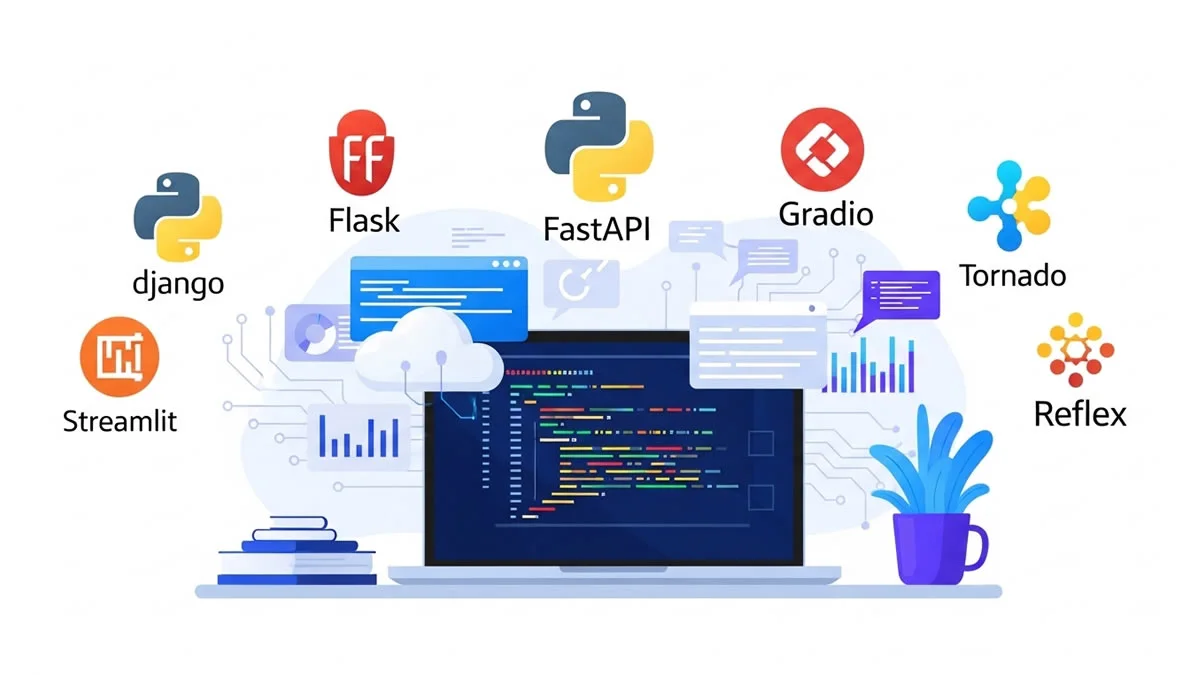Python is beloved not only by engineers and data scientists, but also by web developers worldwide. Its clean syntax, readability, and rich ecosystem of libraries and Python web frameworks make it a compelling choice for building web applications, sometimes even preferred over JavaScript.
Whether you are new to coding or a seasoned developer, Python offers a diverse range of frameworks tailored to your needs. From lightweight tools for quick prototypes to full-stack solutions built for high-traffic production apps, there is something for everyone.
In this guide, we will explore seven of the most popular Python web frameworks. You will learn what makes each unique, what kind of projects they are best suited for, and how they can help bring your ideas to life efficiently and effectively.
Previous Article: WTF is GRPO? The AI Training Method That’s Changing the Game
Python Web Frameworks For Development
1️. Django: Full-Stack Powerhouse for Robust Web Apps
Django is a high-level Python framework built to simplify and accelerate Python web framework development. Known for its “batteries-included” philosophy, it comes with an admin panel, authentication, ORM, and more, right out of the box.
With Django, you can create secure, scalable, and maintainable web applications, from simple websites to enterprise-grade platforms. It promotes clean design and rapid development and has a massive community with thousands of reusable packages.
Best For: Scalable, database-driven websites and complex web apps
Notable Features: ORM, admin dashboard, built-in security, templating engine
2️. Flask: Lightweight and Flexible Microframework
If you are after simplicity and total control, Flask is your friend. It’s a microframework that provides the essentials to get started but leaves architectural decisions up to you. This makes Flask a popular choice for developers who prefer a modular approach.
Flask is perfect for creating REST APIs, small-to-medium-sized applications, or quickly testing out ideas. Thanks to its minimal footprint and clear documentation, it’s also a fantastic starting point for beginners.
Best For: APIs, small web apps, and prototyping
Notable Features: Jinja2 templates, routing, extensible plugins, flexible project structure
3️. FastAPI: Modern and Blazing Fast APIs
If performance matters, FastAPI is a standout. Built on top of Starlette and Pydantic, it supports asynchronous programming, automatic OpenAPI documentation, and fast execution, all while keeping your codebase clean and type-safe.
FastAPI is commonly used for RESTful APIs and backend services, especially in machine learning applications. It’s also beginner-friendly, thanks to features like request validation and IDE autocomplete support.
Best For: High-performance APIs, ML backends, and microservices
Notable Features: Async support, type hints, OpenAPI and Swagger docs
4️. Gradio: Easy Web Interfaces for Machine Learning
Gradio is a game-changer for ML engineers and data scientists. It allows you to create web-based interfaces for your models with just a few lines of code. Whether you want to test models locally or share them with others on platforms like Hugging Face, Gradio makes deployment effortless.
You do not need frontend knowledge or backend setups, just pure Python. It is ideal for building interactive demos and showcasing machine learning models to non-technical users.
Best For: ML model interfaces, demos, and testing
Notable Features: Drag-and-drop UI elements, Hugging Face integration, easy deployment
5️. Streamlit: Rapid Web Apps for Data and ML
Want to turn your data science scripts into shareable web apps fast? Streamlit does exactly that. It allows you to build beautiful, interactive dashboards using only Python, no need to touch HTML, CSS, or JavaScript.
Streamlit is widely used by data scientists, analysts, and researchers for visualizing data, sharing models, or creating internal tools. Its reactive UI and live code updates make it an excellent tool for collaboration and experimentation.
Best For: Data apps, dashboards, ML visualizations
Notable Features: Widgets, caching, live reloading, charts
6️. Tornado: Asynchronous and Scalable Web Framework
Tornado is a powerful framework built for real-time applications and asynchronous performance. Unlike traditional blocking frameworks, Tornado handles thousands of concurrent connections without breaking a sweat, making it perfect for things like chat apps, live feeds, and long polling.
It comes with its web server and is used in performance-critical applications, including by companies like FriendFeed and Quora.
Best For: Real-time applications, long-lived network connections
Notable Features: Non-blocking I/O, built-in server, WebSockets support
7. Reflex: Full-Stack Python, No JavaScript Needed
Formerly known as Pynecone, Reflex lets you build frontend and backend web apps entirely in Python. It compiles Python code into modern web UIs and handles backend logic, so you don’t need to write a single line of JavaScript.
Reflex is great for developers who want a unified stack with a minimal learning curve write once in Python, and deploy everywhere.
Best For: Full-stack apps without JavaScript
Notable Features: Pure Python syntax, frontend/backend integration, fast deployment
Conclusion
Choosing the right Python framework depends on your project goals, skill level, and performance needs. Here is a quick recap:
- FastAPI is ideal for lightning-fast APIs, especially when working with machine learning.
- Gradio simplifies the way you share ML models with stakeholders — zero frontend code needed.
- Django is the go-to framework for building powerful, secure web apps with long-term maintainability.
- Flask is perfect for rapid development and gives developers complete control.
- Streamlit shines in turning data insights into live dashboards fast.
- Tornado is unmatched for real-time apps handling thousands of connections.
- Reflex is your best bet if you want to build full-stack apps with just Python.
No matter your use case, one of these frameworks can help you create fast, secure, and modern web applications all while sticking to the Python language you already love.






